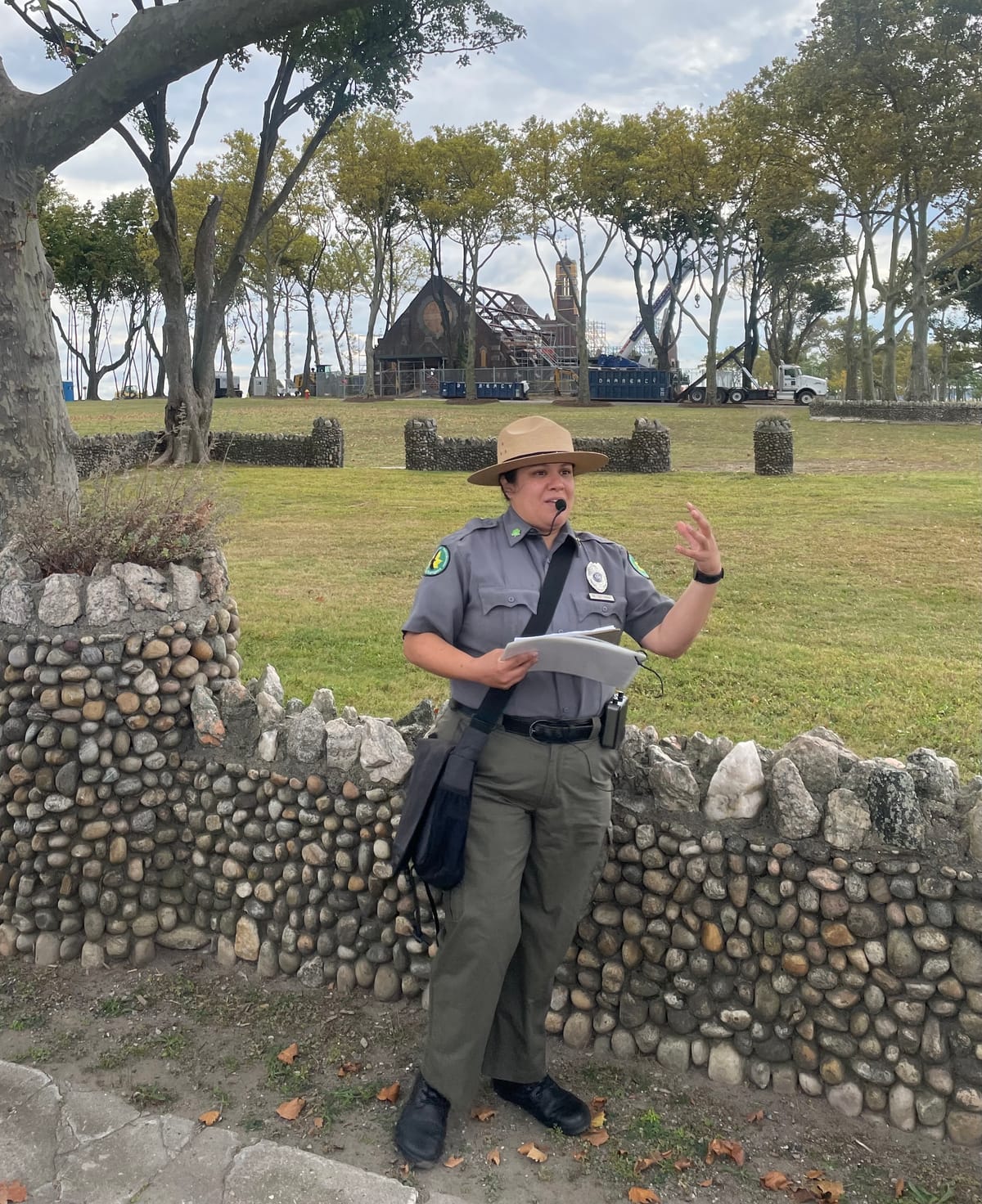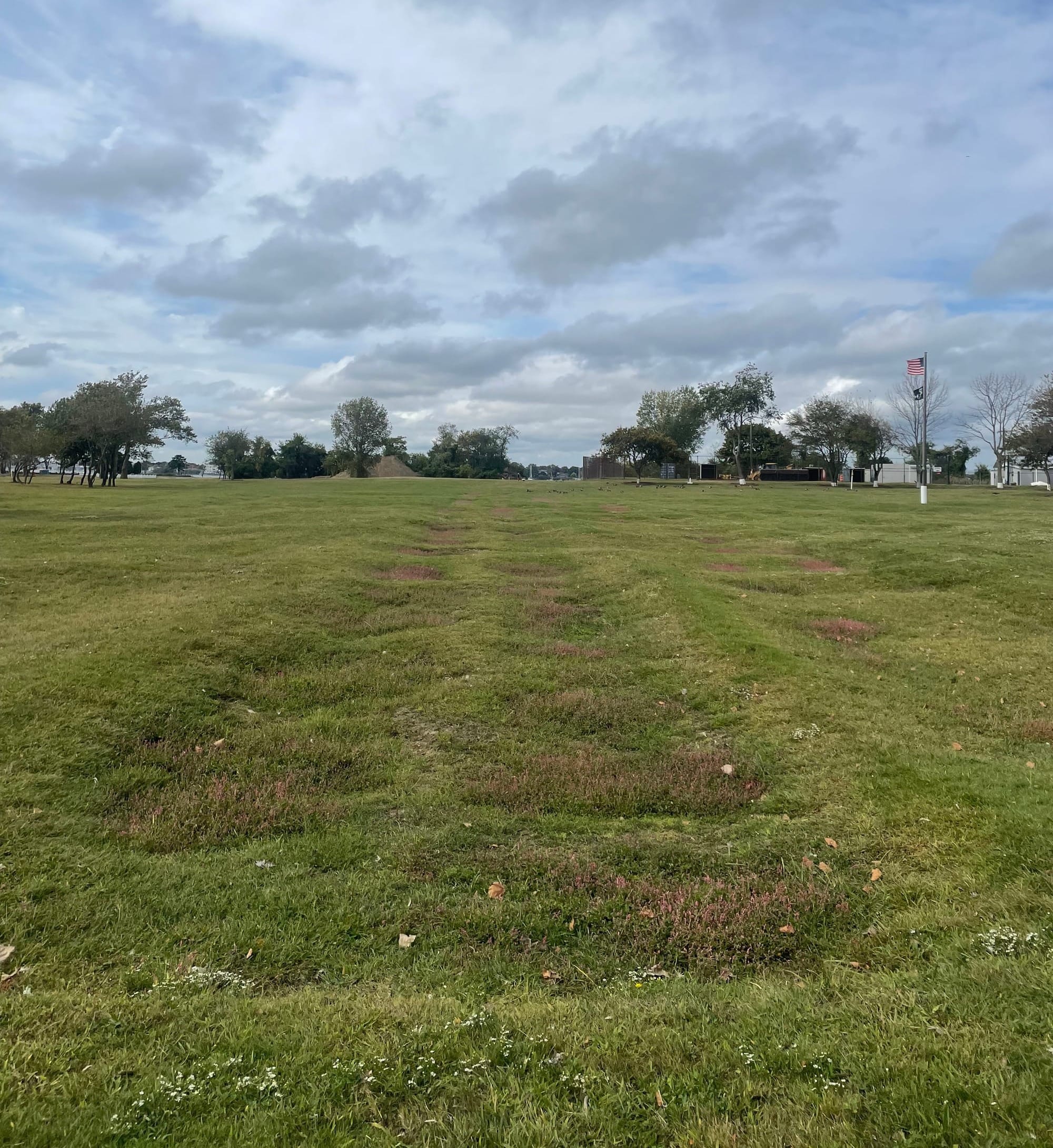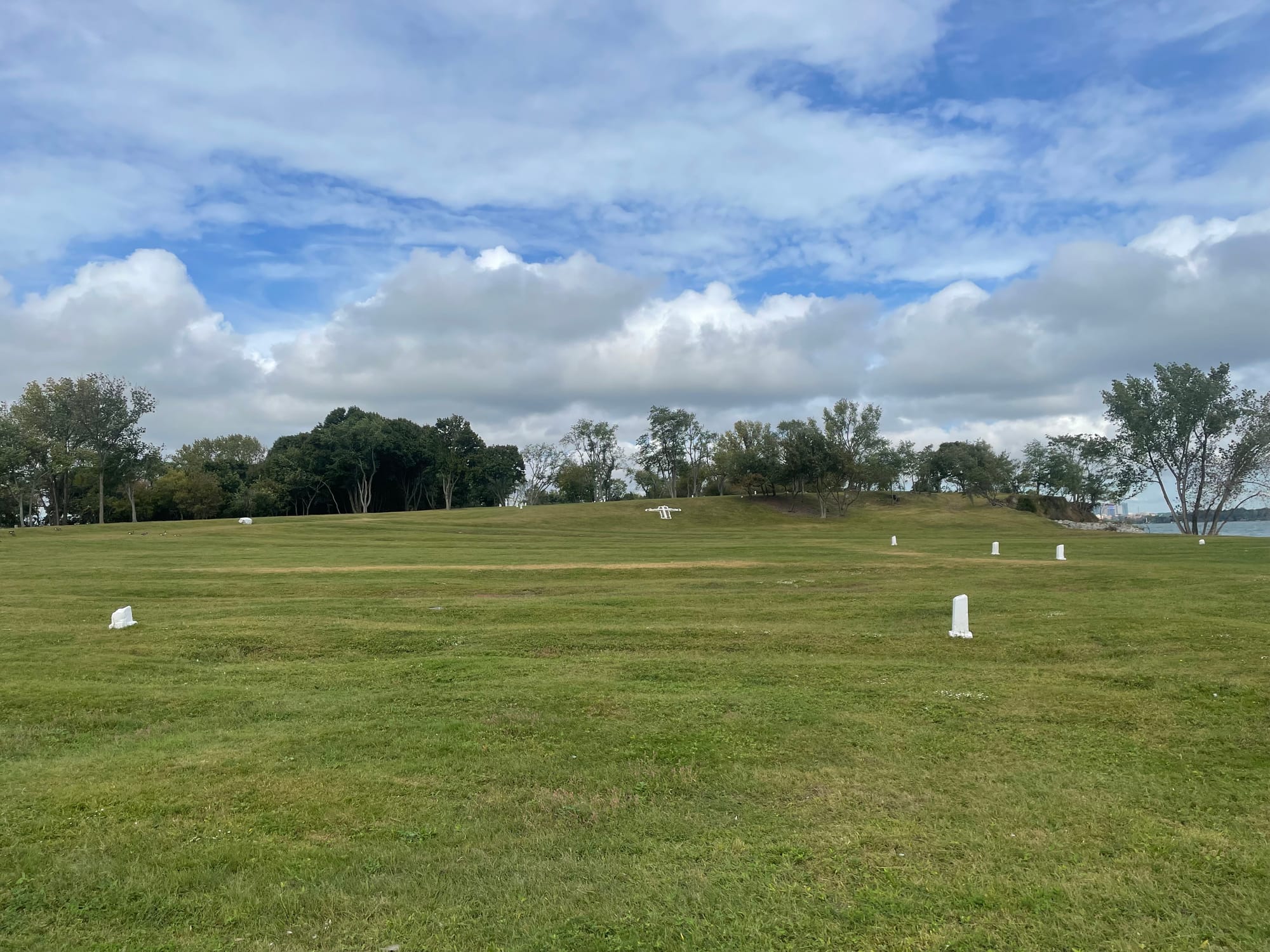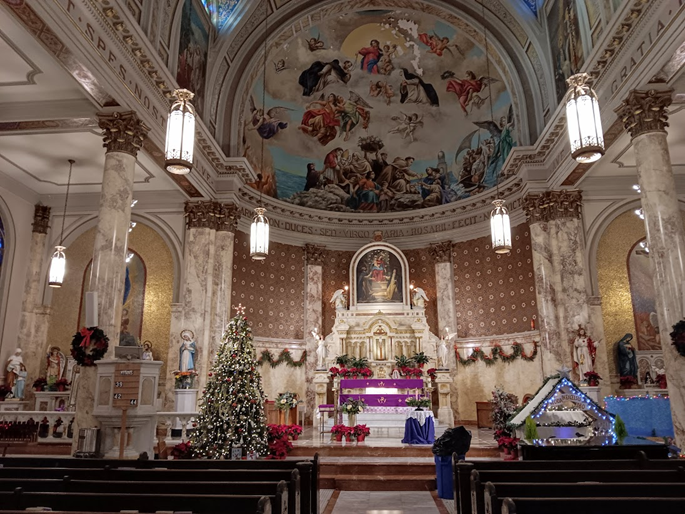Hart Island's mass grave is now open for visitors, but is the city burying its history?
The Hart Island Project says the city is bungling access to the 1 million bodies on the site

Last week I had the chance to visit one of the world’s largest public burial grounds, making the macabre, island-hopping pilgrimage to Hart Island, the potter’s field where an estimated one million New Yorkers are buried. Since then, I’ve learned there’s much more to the island that the recently-opened public tours are leaving out. Some advocates say the city is falling short on its promises to truly reckon with the island’s dark and complicated past as the final resting place for forgotten and unknown residents, and its role as a mass grave for victims of the AIDS crisis and the COVID-19 pandemic.
Twice-monthly public tours of the island first began last November (info on how to go there is at the bottom of this post). The move was heralded by many for finally providing public access to the island that has long been off-limits, even as it holds the collective grief of generations of New Yorkers. Families of the deceased buried on the island weren’t allowed to visit it until 2015, and even then only with special permission and escorts.
But those tours — split into two separate parts, available by entering a lottery — might be missing the promised goal to truly open the island to the public, and in the process, burying some of its more gruesome, but important, history.
The tour, led by the Department of Parks and Recreation, was pretty “disgraceful,” Melinda Hunt, president of the Hart Island Project, told The Groove. “I felt like it was just a poor sixth grade research paper.”
The Hart Island Project incorporated in 2011 as a charity to help map the island’s gravesites, increase access to the island and uncover its stories. After the group successfully lobbied the city in 2019 to open the island to the public, which finally happened in 2023, it received a $50,000 grant from the National Endowment for the Humanities to create an interpretative guide that visitors could use for self-guided tours of the island.
The guide covers Hart Island's ecological, physical and burial history, highlighting the sites of old buildings (now almost all demolished for safety, save for one church), still-standing monuments, various burial sites and an amusement park once known as “negro Coney Island.”
The Parks Department, Hunt said, decided against using that guide, opting instead for tightly-controlled twice-monthly tours that visit only half the island at a time, gloss over much of the history of the mass burial sites and don’t address more complex issues like the practice of recycling grave sites (literally pushing decomposed bones to the side to make room for new caskets) that preserved space on the island.
“It was sort of thin and sweeping it under the table, without really addressing the significance of this cemetery to the American experience,” said Hunt, who’s taken the tour twice but is granted no special access to the island. “The great waves of immigration through Ellis Island are buried there. They hardly mention that.”
(The Parks Department did not respond to questions about the island and Hunt’s comments.)

Hart Island’s one-mile slab of land still receives about 1,000 bodies for burials every year (Hunt says she has data that this number is way higher); about one in 10 COVID deaths in the city were buried there in 2021. Until recently, those graves were dug by inmates in city jails, but that practice stopped in 2020. Now, a landscape company digs large trenches and piles up to 200 simple wooden coffins into each.
It’s relatively easy to become a permanent resident: The burials on the island are the unclaimed or unidentified bodies, or the deceased whose families can’t afford other arrangements. Many people, particularly stillborn infants, once ended up there if families unwittingly opt for a free “city burial” without fully realizing what that means. (Hunt said this no longer happens and that the city provides much more burial assistance these days.)
Just taking a tour is more complicated, however. The lottery system is inherently flawed, Hunt said: the tours are held on Tuesday mornings at 10 a.m., not the most convenient time for many visitors to get to City Island to catch a ferry. Only 10% of applicants win the lottery each time, she said.
Our tour last week included about 20 to 30 people who got on a Department of Transportation ferry for the trip. It was tightly managed by a group of well-meaning but under-prepared Parks rangers, who seemed flummoxed wrangling the required paperwork before the tour started and were often stumped on questions about the island’s history and future.
“What’s refreshing about it over other cemeteries is not having all these monuments. It’s that everybody is buried exactly the same. Nobody gets a marker indicating they are more important than another person.”
The other members in our tour group revealed their pet passions quickly: one woman who looked like she dressed for an art gallery opening kept asking questions about the ruins of old insane asylums (long since demolished); another man specifically asked to see the COVID graves. I have heard the tours are popular with true crime nerds, who have binged various narratives about victims who ended up there. (Full disclosure: I was there as part of a birthday gift from my resourceful partner, who found it while she was looking at a map of the city for new islands we could visit).
Still, it wasn’t hard to see why the city might be limiting access at the moment: the ferry that took us there was made for equipment transfers, not moving people around. The island has port-a-potties but no bathrooms or running water, and old grave sites can become unstable with time as the wooden caskets decompose. On top of that, City Island residents are split about whether adding more ferry traffic to the island would be a good thing, or would overload their quaint Bronx community with tourists.
Family members can make special requests to visit their loved ones on the island, but that’s still not enough access for people who need to process their grief, Hunt said.
“Those are all deeply personal things that people need to be able to go to on their own terms, and not have to win a lottery to visit,” she said. “The purpose of the cemetery is to reconcile death. It’s not a cemetery if you don’t have access; it’s a burial ground. The function of a cemetery is for people to gather and reconcile death. It’s a social space.”

Hunt was able to first visit the site herself in 1991 when her friends in the city were dying during the AIDS crisis. Many of the AIDS victims, according to the rangers on our tour, were buried extra deep underground due to the stigma around the disease at the time.
“You didn’t know exactly what happened to the bodies,” Hunt said. “There were a lot of memorial services without the presence of a body.”
Being able to visit those friends is what she wants for all New Yorkers who know someone buried on the island. But that’s not quite what the public tours are providing, she said.
The Hart Island Project also wants the City Council to consider its proposal to actually end the mass burial practice on the site, switching instead to reusing the existing land by recycling older burial sites and adding more soil on top of others to create more room. This would allow for individual burial sites instead of tightly packed trenches, the group says.
“It’s a no-brainer that it’s not good public relations to conduct mass burials,” Hunt said.
She hopes the city adds a new ferry and dock soon, and that Hart Island is eventually treated like Green-Wood Cemetery or Gettysburg, a place of significant history that welcomes visitors to explore and learn freely.
“What’s refreshing about it over other cemeteries is not having all these monuments. It’s that everybody is buried exactly the same,” she said. “Nobody gets a marker indicating they are more important than another person.”
How to visit Hart Island
Enter the lottery
Drawings are held for twice-monthly free tours, and you can enter here; the lottery usually opens for a 24-hour period about two weeks before each tour. One of those windows is open until midnight tonight (Oct. 10).
The north island tour (the one I went on) visits several grave sites, the peace monument, the former site of a school for delinquent boys and an old underground missile silo which, tragically, you cannot go into.
The south island tour visits the sites of various institutions that were on the island along with the area that was used for AIDS burials.
Request a gravesite visit
These are reserved for family, friends and partners of specific people buried on the island. These are held twice a month on weekends. You can make a request here.
The city allows for “chosen family” and close friends to visit the site too, and the guidelines for that seem to be pretty loose. You can look up who is buried on Hart Island here and here.
Prepare for your tour
Hart Island is raw and open to the elements, with basically no buildings and very little tree cover. This means strong winds, harsh sun and little relief, so bundle up in the cooler months and come prepared with coverings during the summer.
You can take pictures, but rangers request you not photograph open grave sites.
And enjoy City Island while you’re up there. Gosh, this place is cute. On a recent podcast episode, Rep. Alexandria Ocasio-Cortez called it the Hamptons of the Bronx (Dave has family there and insists it’s more of a New England fishing village populated by Yankees fans). Check out the seafood restaurants if you’re into that sort of thing, or grab lunch at the very quant City Island Diner, right down the street from the Hart Island dock. The island is home to a very small movie theater with a very good obscure horror film fest right now.




Comments ()